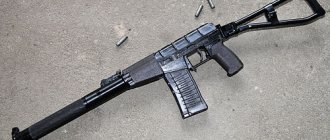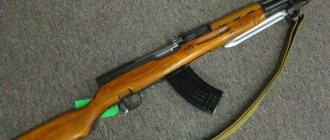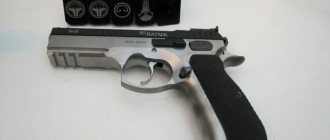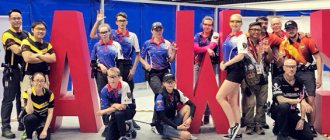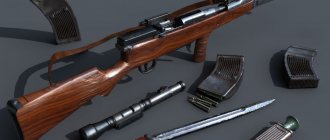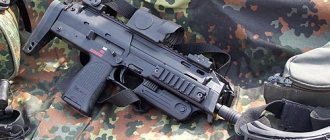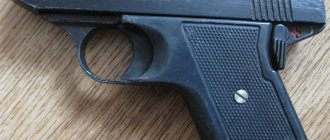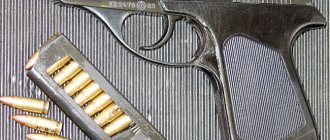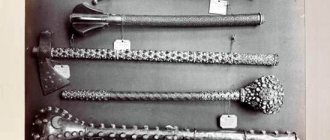SHOT - SILENT, LIKE A SNAKE BITE
As you know, the sound of a shot arises from the rapid expansion of powder gases after leaving the barrel. Their pressure and temperature at the muzzle (for small arms - about 200 kg/cm2 and 1000 ° C, respectively) far exceed these parameters of the surrounding air.
Experts identify three sources of sound: due to powder gases breaking through the gap between the bullet and the wall of the barrel, flying out after it and overtaking it. And at supersonic speed of a bullet (over 320 m/s), a shock (ballistic) wave is formed in front of it in the air, which is also a source of high-frequency sound. It can only be eliminated by making the speed subsonic or using a weapon silencer.
Story
Drawing from the article “Silent Guns” (“Sytin’s Military Encyclopedia”; 1911)
The first PBS appeared before the First World War[1]. Patents for the silencer were registered on March 20, 1894 by the Swiss CA Aeppli and on February 10, 1899 by the Danish gunsmiths Börrensen and Sigbjørsen[2][3]. The first working silencers began to be produced and sold by Hiram Percy Maxim in 1902[ clarify
].
However, until about the middle of the 20th century, silencers were not widely used. Firstly, this was hampered by tactics that did not allow for covert combat, and secondly, by the characteristics of the weapon, most of which were of large caliber and, accordingly, the sound of the shot was weakly muffled. Although there were still weapons with silencers:
- In 1929, the USSR adopted the BraMit silencer, which was installed on Nagan system revolvers and Mosin rifles.
- in the early 1940s In the UK, small arms equipped with integrated silencers were developed and put into service: the Welrod pistol, the De Lisle repeating carbine, the STEN Mk.IIS and STEN Mk.VIS submachine guns.
- in 1942, the silent pistol “High Standard HDM” was adopted in the United States, and in 1944, the US 9 mm SMG submachine gun with an integrated silencer was adopted
The current trend is to simultaneously develop a cartridge, a weapon and a suppressor. Only an integrated approach can achieve significant success. One of the approaches to a comprehensive solution to the problem assumes that only a cartridge with a subsonic bullet speed can radically reduce the sound of a shot, since when fired at a supersonic bullet speed, even with ideal suppression of the sound of the shot, the sound generated by the shock wave remains.
Silencers are produced and used mainly for light small arms (pistols, rifles, machine guns, machine guns). But there are also specific silencers for artillery pieces, used mainly as part of military exercises and experiments.
Silencers are widely used by hunters and amateur athletes[4].
There are also so-called “tactical” silencers, called PMS (Low Noise Firing Device). The PMS is designed to fire cartridges with both subsonic and supersonic muzzle velocity, while the PBS is designed to fire only “subsonic” cartridges with a subsonic muzzle velocity[5].
Silence the sound of a revolver shot
It is much more difficult to muffle the sound of a revolver shot, since gases burst between the chamber of the drum and the barrel. As for submachine guns, their silencers and fore-end are one piece, like the German 9-mm MP-5.
The British came up with something similar - “Sterling Mk 5” - it was used in 1982 during the military conflict in the Falkland Islands (Malvinas) by both the British and Argentine sides. And the Chinese were the pioneers in this matter. Back in the mid-60s, they created the 7.62 mm “64” submachine gun for their own special forces.
Design
The muffler is usually a hollow cylinder made of metal (usually steel, aluminum or copper) or plastic, containing chambers inside to remove exhaust powder gases. As a rule, the muffler is screwed to the end of the barrel using a thread specially made for this purpose.
Muffler device
There is also an integrated silencer containing gas chambers around the perforated section of the barrel. Such a silencer is an integral part of a weapon, without which its combat use is impossible, for example, a special sniper rifle or a special “Val” assault rifle.
Both types of suppressors reduce the noise generated by the shock wave of the ignited charge, which forcefully pushes the bullet out of the barrel. In this case, the gases enter a series of chambers, where they lose their speed, while expanding and cooling. Having significantly lost speed, the gases then exit the muffler.
According to the internal structure, mufflers are divided into single-chamber and multi-chamber, with a preliminary membrane (detaining gases breaking forward from bullets), with flow swirlers and heat-absorbing elements.
Work on weapon silencers
Work on silencers for weapons began at the end of the 19th century, following the introduction of smokeless gunpowder. The first more or less effective device was created in 1898 by the French Colonel Humbert, who installed a cylinder with a valve at the end of a rifle barrel that cuts off the gas flow after the bullet has ejected. And by venting gases back, he hoped to achieve reduced recoil.
But he was never able to cope with the breakthrough of gases to the outside even before the bullet exited. More fortunate was the American P. Maxim (the son of the creator of the first machine gun), who in 1907 modified Humbert’s scheme and hastened to organize a company for serial production of his devices. However, both of them only managed to lower the volume.
Silencer for artillery gun
M60 tank with a silencer on the barrel of a 105-mm tank gun. Silencer for the M109 self-propelled gun of the German Army.
In 1969, the Rock Island Arsenal manufactured an experimental silencer for a tank gun for its own needs. The silencer was intended for testing large-caliber tank weapons at the arsenal shooting range, where there were restrictions on the noise level of the tested weapons. The muffler, 40 feet (12.19 meters) long and 5 feet (1.524 meters) in diameter, had a steel casing with plastic bags filled with water secured inside as noise-absorbing buffers.[6]
In Germany in Meppen, at the training ground of the Technical Center for Weapons and Ammunition of the Bundeswehr (Wehrtechnische Dienststelle für Waffen und Munition 91), a special silencer is used for the M109 self-propelled gun. It was made in order to protect surrounding populated areas from noise during testing of military equipment[7].
Many projects of silencers for weapons
Many projects of silencers for various types of weapons appeared during the First World War. Thus, in Russia, a very simple and rational design was proposed in the summer of 1916 by A. Ertel. Like others, he dealt primarily with silencers for guns, which is quite understandable, given the enormous role of artillery at that time and the method of sound detection of its positions that had already been introduced. But this is what let the inventors down when they turned to rifles: the devices were too cumbersome. And the need for them for small arms has not yet emerged so clearly as to be massively introduced into the troops.
Revolver with a silencer.
Silencers were also used quite little during the Second World War. Note that the limited use and special secrecy gave rise to a lot of rumors and fables about these devices in the 40s. Their rapid development began in the 60s. It is not surprising - it coincided with the development of various intelligence services and “special operations forces.” The problems that Humbert, Maxim and Ertel found difficult to solve are what designers are trying to solve today.
As calculations show, the shot could be made almost silent (with a sound level no higher than 6 dB) by reducing the pressure of the powder gases before their release into the atmosphere to 1.9 kg/sq.cm, and the temperature to 15 - 30 ° C. This task is best accomplished by expansion type mufflers, which are now most widespread.
Notes
- Silent guns // Military Encyclopedia: [in 18 volumes] / ed. V. F. Novitsky ... [and others]. - St. Petersburg. ; [M.]: Type. t-va I. D. Sytin, 1911-1915.
- Handgun Suppressors - THR
- Vinsalt-Forum | Fehlermeldung (inaccessible link)
- Demyan Belyakov
Whisper of Death // Popular Mechanics. - 2020. - No. 6. - P. 66 - 71. - “Silencers”: PMS and PBS
- Experimental silencer, undergoing tests for the Army. // Army Research and Development
, June-July 1969, v. 10, no. 6, p. 18. - Das Photo zeigt eine PzH M109 mit Schalldämpfer bei der Wehrtechnischen Dienststelle (WTD) in Meppen Archived copy from April 6, 2009 on the Wayback Machine (German)
- Code of Administrative Offenses of the Russian Federation 20.9
Close Show Sections
Often, when firing, they try to hide its sound. And the main reason for this is the desire to hide the shot itself or its location. For this task, silencers for weapons were created, or as they are also called sound moderators. They are mainly used by snipers in the army and special forces, although sometimes hunters do not disdain them.
The prices for these accessories fluctuate in a fairly wide range, which is why many try to assemble a muffler at home, sometimes even from improvised means. The main thing is not to forget that the use of sound moderators in Ukraine is completely legal, but only for non-homemade ones. And only on those weapons that are provided for this.
Literature
- Ponomarev Yu.
Biography of PBS: part 1 (Russian) // Kalashnikov magazine. - 2010. - No. 8. - P. 26-30. - Ponomarev Yu.
Biography of PBS: part 2 (Russian) // Kalashnikov magazine. - 2010. - No. 9. - P. 28-32. - Ponomarev Yu.
Biography of PBS: part 3 (Russian) // Kalashnikov magazine. - 2010. - No. 10. - P. 58-62. - Silent shooting weapons (Russian) // Special issue of the magazine “Weapons”. - 2002. - No. 7.
- Ardashev A.
Rusting death (Russian) // Weapons: magazine. - 1998. - No. 03. - P. 10-15. - Ardashev A.
Rustle Death-II (Russian) // Weapons: magazine. - 1998. - No. 06. - P. 30. - Ardashev A.
Rustle Death-III (Russian) // Weapons: magazine. - 1999. - No. 03. - P. 38-40. - Ardashev A.
Rusting death-IV or jamming, so in Russian (Russian) // Weapons: magazine. - 1999. - No. 07. - P. 58-63. - Fedoseev S.
A shot is as silent as a snake bite (Russian) // Weapons: magazine. - 1994. - No. 05. - P. 30-31. - Konovalov N.A., Pilipenko O.V., Skorik A.D., Kvasha Yu.A., Kovalenko V.I.
Silent hand-held firearms. Shot sound reduction devices for machine guns. Design and experimental testing.. - Dnepropetrovsk: NAS of Ukraine, 2008. - 303 p. — ISBN 978-966-02-4374-3. - J. David Truby.
Modern Firearm Silencers: Great Designs, Great Designers. - Paladin Press, 1992. - ISBN 0-87364-666-5. - Krinitsky Yu., Isupov N., Sizov D.
Shot without noise. Improving silent shooting devices based on information modeling of the sound of a shot // Army collection: Scientific and methodological journal of the RF Ministry of Defense. - M.: Editorial and Publishing Center of the Ministry of Defense of the Russian Federation, 2020. - No. 03. - P. 20-25. — ISSN 1560-036X.
Silencers for shotguns
The increasing prevalence of smoothbore shotguns as military weapons prompted designers to develop silencers for shotguns as well. The most successful example is the silencer for the American Escort Mossberg for bodyguards. Today, the main directions of research are to further reduce sound, reduce the weight and dimensions of mufflers, and reduce their effect on accuracy and accuracy of fire. Published reports note that they also have disadvantages such as low reliability (especially when using elastic membranes or washers), and the need for careful individual fitting.
Therefore, they remain a special means, and silent small arms do not yet have prospects of becoming widespread for armies. Recently, to reduce the volume of a shot, it is increasingly recommended to use special cartridges. You can introduce a kind of “wad” into their design, which would push the bullet out, but cut off the powder gases, preventing them from leaving the barrel. Another method of achieving noiselessness is the creation of military pneumatic weapons.
Even in the era of the Napoleonic Wars, Austrian riflemen terrified the brave French with their quiet and accurate “air fittings” with a cylinder in the butt. Work on pneumatics has been going on for decades - so far, however, without significant results.
CLAIM
1. A silencer for a firearm, containing a casing, a filter and partitions spaced apart by bushings with holes whose diameter is not less than the caliber of a bullet, wherein the casing is closed at the ends by a base with a fastening means and a cover, and the base and cover are tightened with pins, characterized in that it additionally contains a hollow rubber seal with the possibility of its rotation in the lid, and the filter is made in the form of a casing made of porous, gas-permeable and heat-conducting metal, except for the part adjacent to the seal, and the heat-absorbing partitions are also made of the mentioned metal, and the holes in the partitions, base and lid made eccentrically, with the first partition additionally equipped with a diffractor with a cap made of soft metal to form a hole corresponding to the caliber of the bullet.
2. A silencer for a firearm, containing a casing, a filter and partitions spaced apart by bushings with holes the diameter of which is not less than the caliber of a bullet, while the casing is closed at the ends by a base with a means for attaching it to the weapon and a lid, and the base and lid are tightened with pins, characterized in that that it additionally contains a hollow rubber seal with the possibility of its rotation in the lid, and the filter is made in the form of a casing made of porous, gas-permeable and heat-conducting metal, except for the part adjacent to the seal, and the heat-absorbing partitions are also made of the mentioned metal, and the holes in the partitions, the base and the cover are made eccentrically, while the first partition is additionally equipped with a diffractor with a cap made of soft metal to form a hole corresponding to the caliber of the bullet, and the fastening means is made in the form of a base with an eccentrically located hole for the bullet, in which there is a metal ring seal with the ability its extension beyond the plane of the base by a spring through a rocker arm, resting with one end on the inside of the base against the shutter, and with the other end interacting with the spring, while the base has a perpendicularly located support platform, on which there are quotation screws and a screw for fastening the platform in the T-shaped groove of the adapter , clamped by a double nut with oval half-holes in which the cam ends of the swivel are located, when rotated around the axis by 90° in the half-holes, the nut is unclenched until it is no longer possible to rotate on the screw thread.
3. A silencer for a firearm, containing a casing, a filter and partitions spaced apart by bushings with holes whose diameter is not less than the caliber of a bullet, while the casing is closed at the ends by a base with a means for attaching it to the weapon and a cover, and the base and cover are tightened with pins, characterized in that that it additionally contains a hollow rubber seal with the possibility of its rotation in the lid, and the filter is made in the form of a casing made of porous, gas-permeable and heat-conducting metal, except for the part adjacent to the seal, and the heat-absorbing partitions are also made of the mentioned metal, and the holes in the partitions, the base and the cover are made eccentrically, while the first partition is additionally equipped with a diffractor with a cap made of soft metal to form a hole corresponding to the caliber of the bullet, and the fastening means is made in the form of a linear pulse mass disconnector containing in the eccentrically located hole of the base a pipe, at the outer end of which there is a thread for attaching it to the barrel of a weapon, and on the inner side there is an eccentrically mounted bushing consisting of two washers connected by a jumper, having a diameter corresponding to the internal diameter of the casing, with the possibility of rotation in its holes of a pipe having a number of radially located recesses on the side surface , in one of which the sleeve is rigidly fixed to the pipe with a locking screw and at the same time pressed from the base by three return springs resting against the base and one of the sleeve washers, two of which are located on the side of the pipe, and the third - under the pipe, and the angle of entry of the pipe thread for to regulate its position on the weapon, in which the muffler does not obscure the sighting devices, it is installed by turning it in the holes of the sleeve and fixing it with a locking screw in one of the recesses on its side surface.
Drawings for RF patent 2397421
The invention relates to small arms and is used to muffle the sound, extinguish the flame of a shot and reduce the recoil of various types of small arms.
The Omega firearms silencer is known (US 6575074), containing a cylindrical casing, rear and front covers with central holes attached to the casing; a threaded hole in the back cover for connection to the barrel of a weapon; deflectors with conical projections and holes on them; pipes with side openings, spaced between the deflectors, forming internal and external expansion chambers.
The disadvantages of this device include insufficient suppression and flame suppression due to the direct passage of some gases through the central hole; insufficient heat dissipation of the casing, which prevents a decrease in the volume of hot gases during firing; a concentric arrangement of a silencer on the barrel of a weapon, obscuring the sighting devices of pistols.
A waterproof silencer for sound, flame and recoil for weapons is known (US 3677132), containing a tubular casing, a rear cover with a central threaded hole for connection to the barrel of a weapon, a front cover with an axial hole, an internal sleeve with expansion chambers formed by rubber or polyurethane seals, sandwiched between metal washers and pipes; a spring that compresses the seals, washers and bushings together.
The disadvantages of this device include the rapid destruction of fixed rubber seals when a bullet passes through the channel inside the muffler and the difficulty of servicing the muffler, which requires constant disassembly and replacement of a large number of rubber gaskets; an increase in the ejection speed of the pistol bolt due to the difficulty of gases escaping from the muffler when the gaskets are not sufficiently destroyed by shots, which leads to a decrease in the service life of pistols; overheating of the housing with insufficient rate of gas discharge from the muffler.
A blocker (pulse mass disconnector) is known for movable connection to the silencer of a semi-automatic weapon (DE 19818714), containing a silencer casing, a rear cover with a central hole connected to the casing by a thread, a pipe with a central hole for the passage of a bullet and a thread for connection to a pistol barrel having a pin to prevent rotation of the pipe in the hole of the back cover, at the other end of which there is a sleeve fixed to it, supported by a return spring and capable of reciprocating movement inside the back cover. The lock also has a cap nut or screw to prevent the pipe from moving inside the back cover when it is not necessary. The device provides pulsed separation of the masses of the silencer and the moving parts of the blocker at the moment of firing.
The disadvantage of this device is its applicability only for silencers with coaxial holes for the passage of a bullet, which with their casing obscure the sighting devices of pistols.
A noise suppressor for pneumatic hammer drills is known (RU 2149225), which includes a housing with an exhaust window, partitions and damping screens made of elastic material, characterized in that a diaphragm enclosed in a casing is attached to the exhaust window, made in the form of a cone made of porous material, and at the top The cone contains a through hole, the cross-sectional area of which is 0.01-0.06% of the cross-sectional area of the hammer drill cylinder. This device effectively muffles sound, but its design is unacceptable for muffling the sound of a weapon shot in the proposed form.
The closest in technical essence and the achieved result is a silencer for firearms (RU 2272234), containing a body, a base with a threaded part, a mesh filter, partitions with central holes whose diameter is not less than the caliber, with a body made of a polymer material with a metal thermal a screen closed at the ends by a base with a threaded part and a lid, tightened by rods on which mesh filters and partitions with central holes are installed, made of rubber, reinforced and spaced with bushings.
The disadvantages of this device are: the low heat capacity of the metal mesh filter and heat shield and the absence of their direct contact with the surrounding air, which makes its natural cooling difficult. As a result, after a limited number of shots, the mesh filter and heat shield heat up and lose their ability to cool the powder gases. In this case, the volume of gases does not decrease and the muffler ceases to effectively dampen the sound and extinguish the flame. In addition, at elevated temperatures, the plastic body of the muffler softens and changes size, which can lead to a significant and irreversible deviation of the axis of the weapon barrel and the axis of the channel of the central holes of the muffler partitions and destruction of the partitions. The stationary position of the rubber partitions leads to their intensive wear when exposed to hot gases. The muffler channel does not overlap during shots and a significant part of the sound wave exits directly from the outlet of the muffler.
The objective of the proposed invention is to create effective silencers in terms of sound dampening, flame suppression and recoil reduction, installed on various types of small arms, including those without threads at the end of the barrel, which do not increase the speed of the weapon's shutter when fired, and which do not obscure their sighting devices.
The problem is solved by the fact that in the proposed mufflers:
according to option 1. A silencer for firearms, containing a casing, a filter, partitions spaced apart by bushings with holes whose diameter is not less than the caliber, closed at the ends by a base with a threaded fastening element and a cover, tightened with pins, while it additionally contains a rotating bullet on an axis in the lid has a hollow rubber seal, and the filter is made in the form of a casing made of porous, gas-permeable, heat-conducting metal, except for the part adjacent to the seal, from which heat-absorbing partitions are also made, and the holes in the partitions, base and lid are made eccentrically, while the first partition is additionally equipped a diffractor with a cap made of soft metal, in which the bullet forms a hole corresponding to its caliber.
according to option 2. A silencer for firearms, containing a casing, a filter, partitions spaced apart by bushings with holes whose diameter is not less than the caliber, closed at the ends by a base with a mechanism for attaching it to the weapon and a lid, tightened with pins, while it additionally contains a rotating bullet on the axis in the lid is a hollow rubber seal, and the filter is made in the form of a casing made of porous gas-permeable heat-conducting metal, except for the part adjacent to the seal, from which heat-absorbing partitions are also made, and the holes in the partitions, base and lid are made eccentrically, while the first partition is additionally equipped a diffractor with a cap made of soft metal, in which the bullet forms a hole corresponding to its caliber, and the fastening mechanism is made in the form of a base with an eccentrically located hole for the entry of the bullet, in which there is a metal ring seal, extended beyond the plane of the base by a spring through a rocker arm resting one end into the seal, on the inside of the base, and the other end interacting with the spring, has a support platform located perpendicular to the plane of the base, on which there are quotation screws and a screw for fastening the platform in the T-shaped groove of the weapon adapter, clamped with a double nut with oval half-holes, in which there are cam ends of the swivel, when rotated around an axis by 90 degrees in the half-holes, the nut is unclenched until it is no longer possible to rotate on the screw thread.
according to option 3. A silencer for firearms, containing a casing, a filter, partitions spaced apart by bushings with holes whose diameter is not less than the caliber, closed at the ends by a base with a mechanism for attaching it to the weapon and a lid, tightened with pins, while it additionally contains a rotating bullet on the axis in the lid is a hollow rubber seal, and the filter is made in the form of a casing made of porous gas-permeable heat-conducting metal, except for the part adjacent to the seal, from which heat-absorbing partitions are also made, and the holes in the partitions, base and lid are made eccentrically, while the first partition is additionally equipped a diffractor with a cap made of soft metal, in which the bullet forms a hole corresponding to its caliber, the fastening mechanism is made in the form of a linear pulse mass disconnector, containing in an eccentrically located hole in the base a pipe, at the outer end of which there is a thread for attaching it to the barrel of a weapon, and on Internally, a bushing consisting of two washers connected by a jumper is eccentrically put on, having a diameter corresponding to the inner diameter of the casing, with the possibility of rotation in its holes of a pipe, which has a number of radially located recesses on the side surface, in one of which the bushing is rigidly fixed to the pipe with a locking screw and at the same time, it is pressed from the base by three return springs resting on the base, and one of the bushing washers, two of which are located on the side of the pipe on studs that tighten the base and the muffler cover, and the third is under the pipe, and the angle of the thread of the pipe to adjust its position on the weapon , in which the muffler does not obscure the sighting devices, is installed by turning it in the holes of the bushing and fixing it with a locking screw in one of the recesses on its side surface.
The inventions are illustrated by drawings:
Fig.1. General view of the muffler (option 1, side view, sectional view).
Fig.2. General view of the muffler (option 1, top view, sectional view).
Fig.3 General view of the muffler (option 2, side view, sectional view).
Fig.4. Clamping bracket with quotation screws and a nut with a swivel (option 2, bottom view, nut in section along b-b').
Fig.5. A clamping bracket on an adapter mounted on a weapon, and a metal seal mechanism put on the barrel and pushed into the muffler by the bolt (option 2, side view, sectional view).
Fig.6. Weapon adapter support platform with a T-shaped groove for attaching the muffler clamping bracket (option 2, top view, section I).
Fig.7. Linear pulse ground disconnector installed at the base of the muffler and closed in a casing (option 3, side view, assembled, in section, in a position pushed into the base of the muffler by springs).
Fig.8. Linear pulse mass disconnector assembly (option 3, side view, sectional view, in a position extended from the base of the muffler).
Fig.9. Linear pulse mass disconnector assembly (option 3, cross-sectional top view).
Fig. 10. Bushing for linear pulse disconnector with bracket.
Fig. 11 Bushing for linear pulse disconnector (option 3, side view, sectional view).
Fig. 12. Linear pulse disconnector with locking screw and pin (option 3, bottom view).
Option 1. The muffler (Fig. 1, 2) consists of a tubular casing 1, closed at the ends by a base 2 and a cover 3, and internal heat-absorbing partitions 4 and 5, separated by removable bushings 6. The base and cover are connected to each other by studs 7, threaded connections 8 in the base 2 and nuts 9 in the cover 3. Heat-absorbing partitions 4 and 5, bushings 6 and cover 3 have holes corresponding to the studs 7. In the cover 3 there is a groove 10, in which there is a rubber seal 11, mounted on an axis 12 with the possibility of rotation around it. The axis 12 has holes at the ends into which the pins 7 pass, fixing the axis 12 across the casing 1. The ends of the axis 12 are also fixed in the grooves 13 of the cover 3. In the base 2, cover 3 and partitions 4 and 5 there are through holes 14, 14′, 14", eccentrically located relative to the axis of the casing 1 for the bullet to fly through the muffler along the a-a' axis. In the hole 14 of the partition 5 there is a tubular diffractor 15, on which a thin-walled, bullet-pierceable cap 16 made of soft metal is put on. The shutter 11 is made in the form of a hollow rubber wheel with a hole for the axis 12, filling the cross-section of the inner part of the groove 10 and closing the free passage of gases from the muffler into the outlet 14" of the cover 3. The casing 1 and heat-absorbing partitions 4 and 5 are made of porous metal with open porosity, having high thermal conductivity, for example Al, Ti, light alloys. The part of the casing 1 adjacent to the groove 10 in the area of contact of the shutter 11 near the outlet hole 14" has a non-porous part 17 to increase the mechanical strength of the casing at the point where the bullet hits the shutter 11. Partitions 4 and 5 have a porosity of about 50 microns, and the casing 1 5 -10 microns.
The connection of the base 2 to the weapon can be made in various ways, for example, threaded 18, in hole 14′ of the base 2, by screwing onto the thread of the weapon barrel (option 1, for pistols with a fixed barrel, with a thread at the end); with clamping bracket 19 (option 2, for pistols that do not have threads at the end of the barrel and require installation of an additional adapter on the pistol, for example PM and its analogues); threaded with a pulse disconnector (option 3, for pistols with automation based on the use of recoil energy with a short barrel stroke, for example the Yarygin pistol, etc.).
Option 2: The suppressor components of Option 1 are used in Option 2, except for the mounting mechanism on the weapon, so that the same reference numbers are used to designate the same components.
According to option 2 (Fig. 3, 4, 5, 6), the clamping bracket 19 consists of a base 2 having a protrusion - a support platform 20, located at an angle of 90° to the plane of the base 2, eccentric to its center. In the middle of the platform 20 there is a hole 21 in which there is a screw 22. With the help of this screw the support platform is secured to the support platforms of the brackets on the weapon. The screw 22 has a head 23 with a flat bottom surface, an unthreaded part and a threaded part. In the middle of the screw 22 there is a transverse oval hole 24, in which there is a pin 25 that prevents the rotation of the screw 22 in the hole 21. At the same time, the screw 22 has the ability to reciprocate along its axis in the hole 21 within the dimensions of the oval hole 24. The threaded part of the screw 22 contains a double nut 26 with a swivel 27, rotating in the half-holes 28 located on the side surfaces of the nut 26. The half-holes 28 have the shape of oval holes in cross-section. The ends 29 of the swivel 27 also have an oval cross-section, forming cams corresponding to the cross-section of the half-holes 28. The long axis of the cross-section of the ends-cams 29 is larger than the cross-section of the short axis of the half-holes 28 of the double nut 26 by the amount of backlash in the nut thread, therefore, when the swivel is in a vertical position relative to the axis of the nut hole, when their cams do not push apart, the nuts rotate freely on the threads of screw 22, and when the swivel is turned to a horizontal position, the cams push the nuts apart and lock them on the thread. To prevent the nut 26 from completely unscrewing from the thread of the screw 22, there is a locking screw 30 in its end part, the head of which prevents the nut 26 from going beyond the end of the screw 22. On the platform 20 there are four adjustment screws 31, designed to accurately set the alignment of the muffler channel with the axis weapon bore.
To prevent gas breakthrough when firing between the end of the barrel and the end of the base 2 of the muffler, in the clamping version 2 of connecting the muffler to the weapon, in the hole 14′ of the cover 2 there is a metal tubular seal 32, pressed by a flange 33 to the inner surface of the base 2 by a spring 34 through a rocker 35. Rocker 35 looks like a fork with three ends. The central end 36 of the rocker fork enters the hole of the spring 34, the side ends rest in the pits 37 of the flange 33. The rocker 35 rests on the inner part of the bracket 38, fixed on the inner surface of the base 2, which forms the axis-support for turning the rocker. The size of the hole in the shutter 32 corresponds to the outer diameter of the barrel of the weapon, for example, a Makarov pistol, and the shutter 32, under the action of the spring 34, moves onto the barrel of the weapon when its bolt is retracted when fired, preventing the breakthrough of gases between the barrel and the muffler. The silencer is attached to the weapon by clamping the head 23 of the screw 22 in the T-shaped groove 39 of the adapter 40, fixed to the weapon, by tightening the nut 24.
Option 3: The suppressor components of Option 1 are used in Option 2, except for the mounting mechanism on the weapon, so that the same reference numbers are used to designate the same components.
According to option 3 (Fig. 7, 8, 9, 10, 11), in order to install a muffler on the barrel of pistols with movable barrels, it is necessary to reduce the inertial impulse of the muffler mass to ensure the operation of the automatic pistol, for which a linear impulse mass disconnector 41 is introduced into the design, separating the mass of the muffler into two parts - a small one (the actual mass of the disconnector) and a large mass of all other parts of the muffler at the moment of firing. The disconnector 41 includes a pipe 42 with a hole for the passage of a bullet 43, larger than the caliber of the weapon, at one end of which there is a thread 44 for screwing onto the thread at the end of the weapon barrel, and at the other end, on its side surface, there is an annular groove 45 for a lock washer 46 Also on the side surface at this end of the pipe there is a number of recesses 47, radially located around the side surface, and two annular grooves 48. The pipe 42 with this end is inserted into the hole 14′ of the base 2 of the muffler, and a sleeve 49, which is two washers, is put on it 50, 50′, with diameters corresponding to the inner diameter of the casing 1, connected by a jumper 51. The washers 50, 50′ have eccentrically located holes 52, 52′ for the pipe 42; holes 53, 53′ for pins 7 and springs 54, 54′, put on pins 7. In the jumper 51 there is a recess 55 for spring 56; threaded hole 57 for the locking screw 58, with the help of which the sleeve 49 is rigidly fixed to the pipe 42 by screwing its end into one of the recesses 47. The position of the screw 58 in the tightened state is fixed with a pin 59 in the holes 60 and 61 of the screw of the jumper 51 of the sleeve 49. The jumper 51 has two holes 62 into which the ends of the bracket 63 are inserted, which serves for additional fixation of the pipe 42 in the sleeve 49. The position of the holes 62 corresponds to the position of the annular grooves 48 on the pipe 42. The casing 1, in option 3, has a steel part in the part adjacent to the disconnector 41 a tubular insert 64 rigidly connected thereto to facilitate the sliding of the sleeve 48 within it. The inner diameter of the insert 64 coincides with the inner diameter of the casing 1.
The muffler works as follows: according to option 1, the muffler is attached to the muzzle of the weapon barrel by screwing the threaded part 18 of the base 2 onto its threaded part. In this case, the axis of the barrel bore coincides with the axis a-a' of the muffler channel. Select the position of the muffler on the barrel so that it does not obscure the sighting devices, and fix it, for example, with a lock nut.
When fired, the bullet and powder gases pass into the first expansion chamber B, formed by the inner surface of the base 2, the walls of the body 1 and the end surface of the heat-absorbing partition 5. The bullet pierces the cap 16, forming a hole on the diffractor 15 corresponding to the caliber of the bullet, which reduces the breakthrough of gases following bullet as it moves further through the partition 5. When the bullet passes through channel 14 of the partition 5, excess pressure is created in chamber B, which is released into the atmosphere through the porous gas-permeable side surface of the casing 1 and, partially, through the porous surface of the heat-absorbing partition 5, which has larger pores , than the pores of casing 1, into chamber C. In this case, the gases are instantly cooled and flame extinguishing occurs. With further passage of the bullet, the same thing happens in chamber C and the heat-absorbing partition 4. When the bullet passes into the hole 14 of the cover 3 of chamber D, the bullet pierces the first wall of the rubber seal 11, turning it at a certain angle on axis 12, passes through the annular channel inside the seal, pierces its second wall from the side of the 14″ hole in cover 3 and flies out of the muffler. When punching holes in the shutter 11, the bullet rotates it on axis 12, replacing the punched area with an undamaged part, which ensures high-quality cutoff of gases inside the muffler during further shots. Powder gases that have not escaped from the muffler through the pores of the casing 1 are cut off by the seal 11 and removed, filtered through the pores of the casing 1. Due to the large pressure relief area and the high thermal conductivity of the material of the porous part of the casing and heat-absorbing partitions, the temperature of the gases drops sharply, their volume decreases, in the pores the frequency and amplitude of sound vibrations changes, which leads to a decrease in the sound strength of the shot by 24 dB (for a Makarov pistol) and complete flame extinguishing. This also helps (compared to silencers with non-porous casing surfaces) to reduce the recoil speed of the pistol bolt when fired, approaching the recoil speed of a bolt without a silencer. This increases the “survivability” of the pistol and significantly reduces the amount of powder gases escaping through the barrel chamber when the cartridge case is ejected, when pressure is released from the muffler housing. Rotating the rubber shutter 11 on the axis with each shot helps to increase the life of the shutter up to 60 shots until the sound of the shot increases by 4 dB. To replace the seal 11, unscrew the nuts 9, remove the cover 3 from the casing 1, press the used seal with your finger so that it comes out into the lower part of the groove 10 of the cover 3 along the grooves 13. Remove the axis 12 from the used seal, insert it into the hole of the new seal and insert the seal into the groove 10 and grooves 12 of the cover 3. The cover 3 is put on the studs 7 so that they fit into the holes of the axis 12 and when the cover 3 is further closed, they come out into the sockets of the nuts 9. Screw in the nuts 9. The studs 7 are tightened, and install the holes of the base , partitions and muffler cover along axis a-a'.
When it rains or when the muffler is submerged in water, the porous muffler housing becomes saturated with water. When fired, the suppression properties are improved by 3-5 dB due to the consumption of gas energy to remove water from the pores and an increase in the heat capacity of the wet silencer.
If necessary, the silencer can be used without rubber seal 11. In this case, the reduction in the sound of the shot is 18 dB (for a Makarov pistol with a PPO cartridge).
According to option 2, for a weapon that does not have a thread on the muzzle, the silencer can be installed through a clamping bracket 19 and an adapter 40 installed on the weapon. The muffler is attached to the adapter 40 by inserting the support pad 20 of the bracket 19 into the groove 39 of the adapter so that the quotation screws 31 touch its lower surface. In this case, the screw 22 enters the open T-shaped groove 39 until it stops. Having turned the swivel 27 to a vertical position, rotate the double nut 26 with it, attracting the head 23 of the screw 22 to the bottom of the T-shaped groove 39. The screw, without rotating, moves forward within the oval hole 24, across the pin 25. After clamping the head of the screw 22 in groove 39, swivel 27 is turned to a horizontal position. In this case, the cam ends 29 of the swivel expand the double nut 26, removing the backlash of the thread and locking it on the thread of the screw 22. The adapter 40 with the attached silencer is fixed on the muzzle of the weapon barrel so that the axis of the barrel coincides with the axis aa of the silencer, and the protruding end of the seal 32 is put on to the end of the weapon barrel.
Setting the alignment of the weapon barrel and the silencer channel is carried out as follows. After pre-installing the silencer on the weapon adapter, precise alignment is performed. To do this, remove the rubber seal 11 from the muffler cover 3 and insert the cover into place. A rod corresponding to the diameter of the bore is inserted into the barrel through the muffler, so that it goes into the barrel at least 50 mm and rises slightly above the surface of the cover 3. If the rod touches the wall of the outlet hole 14" of the cover 3, loosen the nut 26 and use the quotation screws 31 to deflect the muffler to a position in which the rod is installed concentrically in hole 14". After this, the rod is removed from the barrel and the muffler, the seal 11 is installed in the cover 3 and the cover is installed on the muffler.
According to option 3, a linear pulse disconnector 41 is installed in the muffler as follows. To assemble it, pipe 42 is inserted from the outside into hole 14′ of base 2; insert the spring 56 into the recess of the base 2, put the springs 54, 54′ on the studs 7, inserted inside the sleeve 49 through holes 53′, 53, after which the studs are screwed into the base 2. Put the sleeve 49 on the inner end of the pipe 42 with hole 52 towards the base 2 so that the spring 56 enters the recess 55. Having compressed the springs, the sleeve 49 is fixed on the pipe 42 with a lock washer 46 in the annular groove 45 and a bracket 63 through the holes 62 in the annular grooves 48 with the possibility of its rotation in the holes 52, 52′. The threaded part 44 of the pipe 42, behind its end with a hexagon protruding from the base 2, is screwed onto the threaded part of the weapon barrel until it stops. Set the angle of rotation of the pipe 42 in the muffler sleeve 49 to a position where the base 2 does not obscure the sighting devices of the weapon. A screw 58 is screwed into the hole 57 so that its end falls into one of the recesses 47. In this case, the pipe 42 loses the ability to rotate in the holes 52, 52′ and is rigidly fastened to the sleeve 49. To fix the position of the screw 58 in a tightened state in the holes 61 and 60 of the jumper 51 and screw 58 insert the pin 59. After these operations, the position of the thread 44 of the pipe 42 will be in a position corresponding to the normal location of the muffler for a particular gun, and its installation can be done by screwing onto the base 2 and the casing 1, and not by the pipe 42 Place partitions 4 and 5, bushings 6, 6′, casing 1, cover 3 on studs 7 and tighten everything with nuts 9.
A muffler with a linear impulse mass disconnector, option 3, works as follows. When a pistol is fired, the barrel with the pipe 42 screwed onto it, under the influence of recoil, begins to move sharply away from the muffler, dragging the pipe 42 and bushing 49 with it, while compressing the springs 56, 54, 54′. Bushing 49 slides with washers 50, 50′ along the inner surface of insert 64, and the muffler casing and its other parts, by inertia, do not move behind the barrel of the weapon for some time until they are compressed to the end of the spring, without interfering with the operation of the automatic pistol. After the shot, springs 56, 54, 54′ return the sleeve 49 and pipe 42 to their original position.
The test results showed the high sound dampening ability of mufflers made of gas-permeable porous metals. Due to the large area of pressure relief and high thermal conductivity of the material of the porous part of the casing and heat-absorbing partitions, the temperature of the gases drops sharply, their volume decreases, the frequency and amplitude of sound vibrations in the pores changes, which leads to a decrease in the sound strength of the shot by 24 dB (for a Makarov pistol) and complete flame suppression This also helps (compared to silencers with non-porous casing surfaces) to reduce the recoil speed of the pistol bolt when fired, approaching the recoil speed of a bolt without a silencer. This increases the “survivability” of the pistol and significantly reduces the amount of powder gases escaping through the barrel chamber when the cartridge case is ejected, when pressure is released from the muffler housing. Rotating the rubber shutter on the axis with each shot increases the life of the shutter up to 60 shots and increases the sound of the shot by 4 dB. Soaking the porous muffler casing with water does not interfere with the operation of the muffler and further reduces the sound of the shot.
The use of a clamping option for attaching a silencer to a weapon that does not have a thread on the barrel (Makarov pistol) showed the possibility and effectiveness of this method of attachment when using an adapter with a T-shaped groove, which is additionally installed on the pistol. The installation time of the clamping bracket in the T-shaped groove is 4-5 seconds, which is two times less than when screwing the muffler onto the thread. The clamping bracket allows you to adjust the position of the silencer relative to the axis of the weapon's barrel. The retractable metal seal effectively prevents gases from escaping between the barrel and the base of the muffler.
The use of a linear pulse mass disconnector installed inside the muffler allows it to be used for semi-automatic pistols with moving barrels, ensuring the operation of their automation, and its eccentric location inside the muffler with the ability to change the angle of the thread in the connection pipe to the weapon allows the use of standard sights.
Causes
To deal with the sound of a gunshot, you need to understand what is its source. Usually this:
- The sound of the weapon's mechanism firing. This could be the clanging of the shutter, the strike of the firing pin on the primer, and the like. For example, in an open area on a quiet night, the metal parts of the mechanism of a Kalashnikov assault rifle can be clearly heard at a distance of up to fifty meters. Therefore, when it is necessary to fire one completely silent shot, a single-shot weapon is used.
- The sound created by the air that is in the barrel before the shot. It is displaced by a bullet and powder gases. This is especially true at the moment of their exit from the trunk. Powder gases for the most part move after the bullet. But some of them can break through into the gap between the ammunition and the barrel, or even into existing cracks, as in revolvers. Silencers are created to combat the first option.
- An acoustic shock wave that forms behind a bullet. This occurs when the speed of the ammunition is greater than that of sound (330 meters per second). Physically, this phenomenon is explained by the fact that when a bullet passes through the air, it creates waves similar to those that can be observed on water. Their volume is not great if they move faster than the projectile. But if the speed of sound is exceeded, then the bullet seems to accumulate the energy of the wave that follows it. Therefore, to the human ear it is heard as a blow, similar to thunder in a thunderstorm. You can get rid of this only by reducing the speed of the bullet. This is achieved by shortening the barrel of the weapon or by using special cartridges with a small charge of gunpowder.
- The sound of a projectile hitting a target.
Masking fee
Of course, you have to pay to disguise a fighter in this way. Any silencer reduces the initial speed of a bullet, which affects the lethal effectiveness of the weapon. This happens due to a reduction in muzzle pressure.
In addition, silencers impose a conditional limitation on the ammunition used. The fact is that the cartridges should have as little powder charge as possible. Otherwise, excess shot power will cause rapid wear of the PBS. Finally, the muffler gets very hot during shots, which can also cause its rapid failure.
Do you want to know even more interesting things about weapons? How about reading about 5 “Hollywood” facts about pistols that have nothing to do with reality.
Did you like the article? Then support us, click
:
- May 19, 2019
- Weapons and ammunition
- Human
Issues of camouflage are almost always important to some extent. It doesn’t matter what we are talking about - war or simple hunting. This is necessary in order to gain a certain advantage. An important issue in this regard is noise reduction. And within its framework, let's look at how a weapon silencer works.
How to make a homemade silencer for a pistol?
Homemade weapon silencers are not the best option. After all, in order for such a product to fully fulfill its functions, and also be safe to use, it is necessary to carry out many calculations, select the right materials and assemble this entire structure. And this is not so simple, especially in “handicraft” conditions. And even if you do everything correctly, there is no guarantee that you will get exactly the result you were looking for. Therefore, we strongly advise you not to engage in this matter yourself. It’s better to go to specialized stores where you can choose and buy not only a sound moderator for your carbine or pneumatic rifle, but also other weapon tuning.
Some craftsmen, of course, try to make mufflers from PET bottles or oil filters from MANs. The first option generally looks comical, and the second one may drown out something, but it won’t work for long and can be dangerous to use. Of course, there is another option: dig up a couple of drawings on the Internet and contact some turner. But this will not guarantee that you will get exactly what you wanted. Therefore, it is better not to take risks, but to turn to professionals with this issue.
What about smooth-bore weapons?
Is it possible to do something about it? After all, the conversation so far has been about rifled weapons. Is it possible to attach a silencer to a shotgun? We should start here with the materiel. First of all, it is necessary to take into account that smooth-bore weapons can fire not only bullets, but also buckshot and shot. Which, as is known, deviate to a certain extent from the flight path. Not very much, but it is there. Therefore, the muffler has to be increased. In addition, the sound is not very strongly suppressed. Up to about 2/3 of the maximum level. This is a relatively comfortable indicator, allowing you to shoot in an indoor shooting range/small caponier without using additional hearing protection. A silencer for smooth-bore weapons is not as effective a device as those designed for rifled weapons. By the way, you should not think that they are interchangeable. If you try to use a silencer from a rifled weapon for a smooth-bore weapon when shooting shotguns, it will most likely rupture or cause other unpleasant damage.
